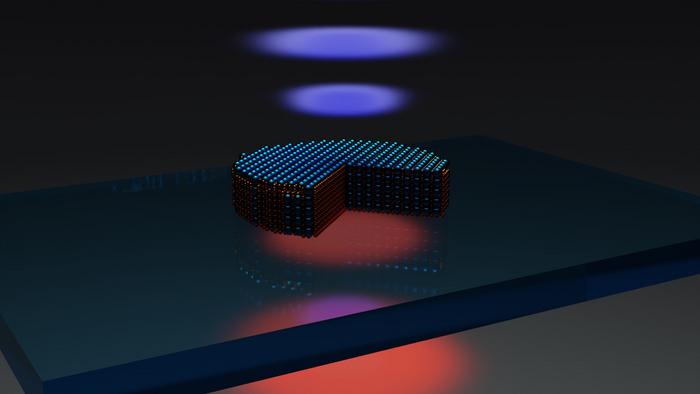
Nanodisk Device Could Advance Nonlinear, High-Index Nanophotonics
GOTHENBURG, Sweden, Sept. 23, 2024 — A photonics nanostructure that combines a high refractive index with extreme optical nonlinearity could offer a compact, efficient option for compressing light and changing light frequency. The nanodisk structure could be integrated into optical circuits or used in the miniaturization of photonic devices, in addition to being used as a research tool.
The nanodisk was developed by a team from Chalmers University of Technology, who fabricated the disk using molybdenum disulfide (MoS2) from the transition metal dichalcogenide (TMD) family of materials. This atomically thin material has exceptional optical properties at room temperature. However, it is difficult to stack without risking the loss of its nonlinear properties, because of its crystalline lattice symmetry constraints.
The researchers exploited the 3R phase stacking order of a MoS2 multilayer to achieve resonant nonlinear nanophotonics in the nanodisk. The lack of inversion symmetry, even in the bulk of the material, enabled huge second-order susceptibility, a high, anisotropic refractive index in the NIR region (greater than 4.5), and low absorption losses, underlining the value of 3R-MoS2 for nonlinear nanophotonics.

Schematic of the optical experiment: A near-infrared laser excites the nanodisk fabricated from the 3R-MoS2 flake, standing on a glass substrate. The quarter-cut section of the disk schematically shows that the incident laser excites optical resonances, leading to red areas in the image that represent the higher density of the electromagnetic field. This localization, along with the crystalline lattice broken inverse symmetry, allow for effective conversion of the red pump laser into blue light. Courtesy of Chalmers University of Technology/Georgii Zograf.
“We have fabricated for the first time a nanodisk of specifically stacked molybdenum disulfide that preserves the broken inverse symmetry in its volume, and therefore maintains optical nonlinearity,” researcher Georgii Zograf said. “Such a nanodisk can maintain the nonlinear optical properties of each single layer. This means that the material’s effects are both maintained and enhanced.”
The researchers fabricated 3R-MoS2 nanodisks of various radii that supported resonant anapole states. They observed a greater than 100-fold enhancement of second-harmonic generation in a single resonant nanodisk, compared with an unpatterned flake of the same thickness. The enhancement was maximized at the spectral overlap between the anapole state of the disk and the material resonance of the second-order susceptibility. These results indicated that the nanodisk was efficient in localizing the electromagnetic field and generating doubled frequency light out of it.
“It really is a milestone, particularly due to the disk’s extremely small size,” professor Timur Shegai, who led the research, said. “Second harmonic generation and other non-linearities are used in lasers every day, but the platforms that utilize them are typically on the centimeter scale. In contrast, the scale of our object is about 50 nanometers, so that’s about a 100,000 times thinner structure.”
The nanodisk is made from material that can be transferred to any substrate without the need to match the atomic lattice with the underlying material. The material used to build the nanodisk has a high refractive index, allowing light to be effectively compressed in the disk.
“The disk-looking structure is much smaller than the wavelength of light, yet it’s a very efficient light frequency converter,” Zograf said. “It is also 10,000 times, or maybe even higher, more efficient than the unstructured material of the same kind, proving that nanostructuring is the way to boost efficiency.”
The researchers believe that MoS2, a compact material with outstanding optical properties, could help drive the development of advanced optical and photonic applications forward.
“We believe it can contribute towards future nonlinear nanophotonics experiments of various kinds, both quantum and classical,” Shegai said. “By having the ability to nanostructure this unique material, we could dramatically reduce the size and enhance efficiency of optical devices, such as nanodisk arrays and metasurfaces. These innovations could be used for applications in nonlinear optics and the generation of entangled photon pairs.”
The researchers’ approach could potentially enhance the entire spectrum of optical second-order nonlinear processes in nanostructured van der Waals materials, opening the way for nonlinear and quantum, high-index transition-metal dichalcogenide nanophotonics.
“This is a first tiny step, but a very important one. We are only just scratching the surface,” Shegai said.
The research was published in Nature Photonics (www.doi.org/10.1038/s41566-024-01444-9).
Published: September 2024